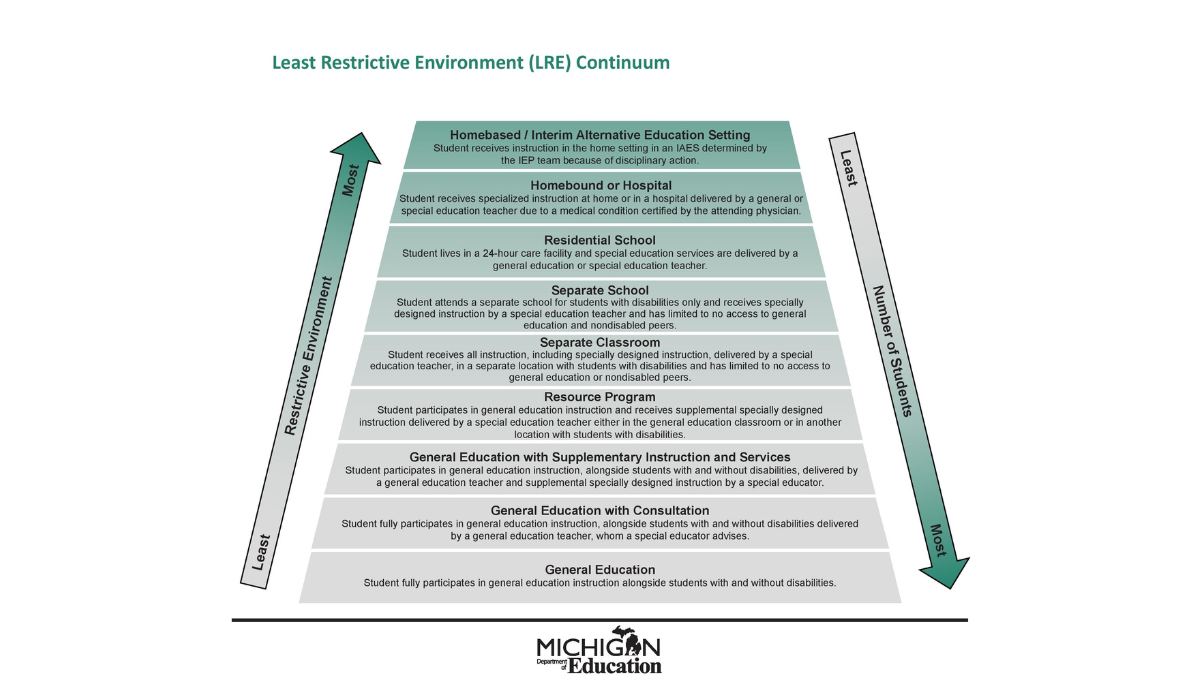All students with disabilities are general education students first. Students with disabilities are not guests in the general education classroom. They are full members of the general education community, with the right to be included and supported within the general education environment. The purpose of special education, including the provision of specially designed instruction in the LRE, is to ensure a student with a disability has access to and makes progress in the general education curriculum and meets the same standards that apply to all students. Students must be taught alongside their typically developing peers as much as possible. Special education services and placement are not tied to an eligibility label, as the IEP is individualized for each student.
- Least Restrictive Environment: The Requirements Package MDE
- Specially Designed Instruction includes adapting the content, methodology, and/or delivery of instruction to address the individual needs of the student while ensuring access to the general education curriculum.
-
IEP Development and Implementation: Supplementary Aids and Services understanding supplementary aids and services and how they are used to support placement of a student with a disability in the LRE.
- Placement Issues CPIR
Least Restrictive Environment LRE
The regular classroom in the school the student would attend if not disabled is the first placement option considered for each student before a more restrictive placement is considered. Placement must be discussed annually.
When the IEP team (which includes the parents) decides where a child will be educated, it must ask what can be provided so the child can stay in the regular education classroom. It must consider what supplementary aids and services (extra supports) will allow the child to be placed in a regular classroom environment.
Examples might include assistive technology, special behavior strategies, use of a resource room, paraprofessional support, or accommodations or modifications of assignments.
What other settings are there besides a regular classroom?
School districts make available a range of placement options to meet the unique educational needs of students with disabilities. The continuum of placements include:
- a general education class
- a special education class
- a special education school
- at home
- in a hospital or other public or private institution
Any alternative placement selected must maximize opportunities for the student to interact with nondisabled peers.
What does the law say?
IDEA REGULATION §300.114(a)(2) General LRE requirements: Each public agency must ensure that—
(i) to the maximum extent appropriate, children with disabilities, including children in public or private institutions or other care facilities, are educated with children who are nondisabled; and
(ii) special classes, separate schooling or other removal of children with disabilities from the regular educational environment occurs only if the nature or severity of the disability is such that education in regular classes with the use of supplementary aids cannot be achieved satisfactorily
- LRE:A Simplified Guide to Key Legal Requirements PACER
- Considering LRE in Placement Decisions CPIR
- Extent of Nonparticipation CPIR
What about extracurriculars or other school activities?
LRE means students with disabilities are educated, to the maximum extent appropriate, alongside their nondisabled peers, while still meeting their unique educational needs.
The IEP team must consider the whole student-their social, emotional, and behavioral needs as well their academic needs, and their entire educational environment . This may require the provision of supplementary aids and services in nonacademic settings such as the lunchroom, playground and/or extracurricular activities. The educational environment includes:
- Core classes
- Electives
- Lunch
- Recess
- Passing time
- Unscheduled activities and scheduled but inconsistent activities (fire, tornado, and lockdown drills)
- Assemblies
- Camps
- Field trips
Does LRE apply to students of all ages?
Educational services for students with disabilities should be provided in schools where peers without disabilities attend, in age-appropriate general education programs, under the direct supervision of general education teachers, with special education support and assistance as determined appropriate through the student’s IEP.
Placement decisions, including those related to transition services, must be based on these principles of LRE.
- Preschool in the LRE Michigan Dept of Education
- Transition to Preschool Resources
- LRE Applies to Preschool US Dept of Education
We know that where a child attends preschool can set the trajectory for the rest of their educational career. In Michigan, the majority of young students with disabilities are not being educated with their typical peers. A statewide workgroup has identified specific actions to consider.
Where can I learn more and get support?
- Increasing Engagement and Independence in General Education A tool developed by Michigan Alliance for Families and the Statewide Autism Resources and Training (START) Project to provide clarity for families and promote collaboration.
- Access to General Education
- Dispute resolution Parents have the right to disagree with decisions that the school system makes.
- Contact Michigan Alliance for Families 1-800-552-4821
- Kids Together
- Disability is Natural


